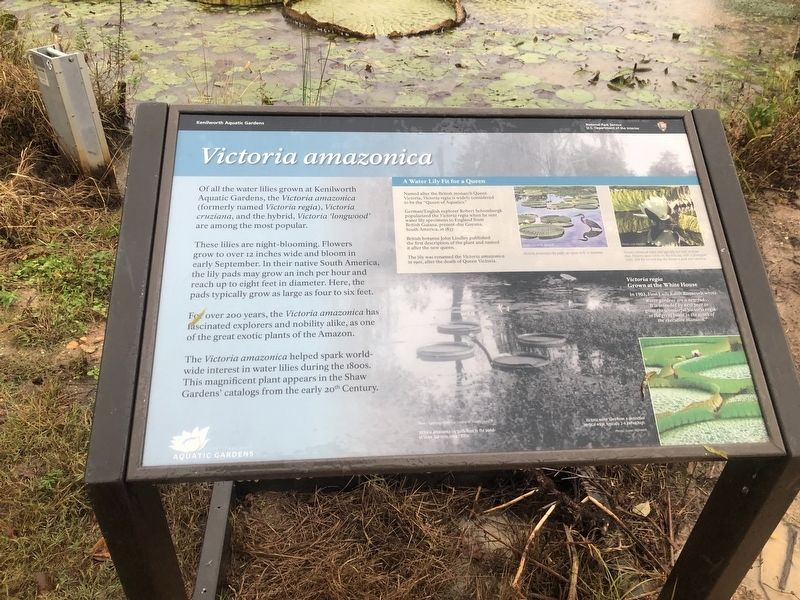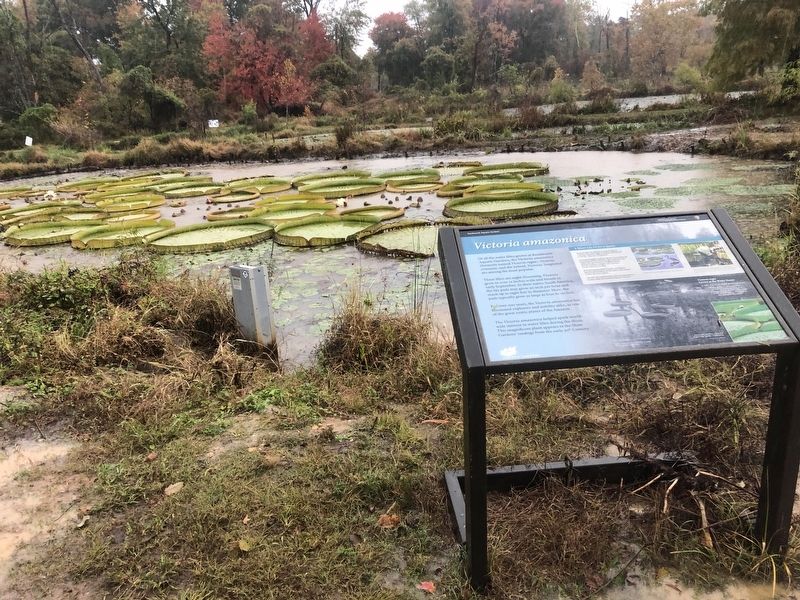Kenilworth Park in Northeast Washington in Washington, District of Columbia — The American Northeast (Mid-Atlantic)
Victoria amazonica
Kenilworth Aquatic Gardens
— National Park Service, U.S. Department of the Interior —
Of all the water lilies grown at Kenilworth Aquatic Gardens, the Victoria amazonica (formerly named Victoria regia), Victoria cruziana, and the hybrid, Victoria 'longwood' are among the most popular.
These lilies are night-blooming. Flowers grow to over 12 inches wide and bloom in early September. In their native South America, the lily pads may grow and inch per hour and reach up to eight feet in diameter. Here, the pads typically grow as large as four to six feet.
For over 200 years, the Victoria amazonica has fascinated explorers and nobility alike, as one of the great exotic plants of the Amazon.
The Victoria amazonica helped spark worldwide interest in water lilies during the 1800s. This magnificent plant appears in the Shaw Gardens' catalogs from the early 20th Century.
[Asides:]
A Water Lily Fit for a Queen
Named after the British monarch Queen Victoria, Victoria regia is widely considered to be the "Queen of Aquatics."
German/English explorer Robert Schomburgk popularized the Victoria regia when he sent water lily specimens to England from British Guiana, present-day Guyana, South American in 1837.
British botanist John Lindley published the first description of the plant and named it after the new queen.
The lily was renamed the Victoria amazonica in 1901, after the death of Queen Victoria.
Victoria regia
Grown at the White House
In 1903, First Lady Edith Roosevelt wrote:
"Water gardens are a new fad. . .
It is intended by next year to
grow the wonderful Victoria regia
in the great basin to the south of
the executive mansion."
Erected by National Park Service, U.S. Department of the Interior.
Topics. This historical marker is listed in these topic lists: Environment • Horticulture & Forestry • Women. A significant historical year for this entry is 1837.
Location. 38° 54.795′ N, 76° 56.69′ W. Marker is in Northeast Washington in Washington, District of Columbia. It is in Kenilworth Park. Marker can be reached from Anacostia Avenue Northeast, 0.1 miles west of Ponds Street Northeast, on the right when traveling west. Touch for map. Marker is at or near this postal address: 1550 Anacostia Avenue Northeast, Washington DC 20019, United States of America. Touch for directions.
Other nearby markers. At least 8 other markers are within walking distance of this marker. Under the Boardwalk (about 400 feet away, measured in a direct line); Beauty and Business (about 500 feet away); Aquatic Greenhouse #3 (about 800 feet away); Preserve and Protect
Additional keywords. Victoria amazonica
Credits. This page was last revised on January 30, 2023. It was originally submitted on October 27, 2019, by Devry Becker Jones of Washington, District of Columbia. This page has been viewed 151 times since then and 8 times this year. Photos: 1, 2. submitted on October 27, 2019, by Devry Becker Jones of Washington, District of Columbia.

